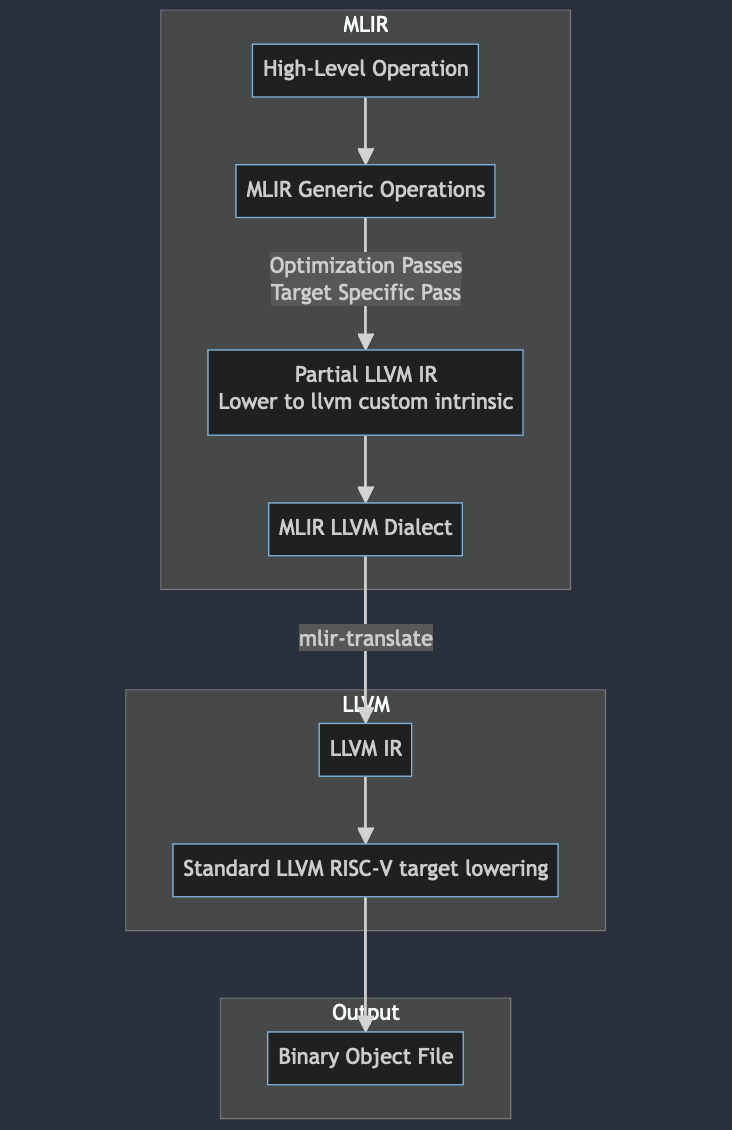HW-SW co-design in the RISC-V Ecosystem [Part 4]: Executing Custom Instructions on Spike
12 May 2024 #compilation #llvm #mlirThis is the final part of the 4 part blog series of Hardware-Software codesign, starting from MLIR to execution of custom instructions on a RISC-V Instruction set simulator (ISS). In this part, we will focus specifically on adding the custom instructions to Spike, which is the golden reference ISS for RISC-V.
Recall the encoding of the approximate multiplication instructions for floating point numbers from the previous post. These instructions, known as fmul_exp_m_s, fmul_exp_s, fmul_exp_m, and fmul_exp, serve as proxies for approximate multiplication operations within RISC-V processors.
# instruction encoding
fmul_exp_m_s rs2 rs1 rd 31..25=0b1111100 14..12=0b111 6..0=0b0001011
fmul_exp_s rs2 rs1 rd 31..25=0b1011100 14..12=0b111 6..0=0b0001011
fmul_exp_m rs2 rs1 rd 31..25=0b1101100 14..12=0b111 6..0=0b0001011
fmul_exp rs2 rs1 rd 31..25=0b1001100 14..12=0b111 6..0=0b0001011
Based on the patch to LLVM that we defined, we can create an executable that can be directly executed in spike. These commands are already available via a Makefile in the accompanying github repository.
llc -march=riscv64 -mattr=+f,+xnn -target-abi=lp64 -O2 -filetype=asm benchmark_llvm.ll > benchmark_llvm.s
clang -target riscv64 -march=rv64imaf_xnn -mabi=lp64f -I. benchmark_llvm.s > benchmark.o
clang -target riscv64-unknown-elf \
-march=rv64imaf_xnn -mabi=lp64f \
-static \
-Tcommon/riscv.ld \
-nostdlib -nostartfiles \
--sysroot="<>/homebrew/opt/riscv-gnu-toolchain/riscv64-unknown-elf/" --gcc-toolchain="<>/homebrew/opt/riscv-gnu-toolchain/" \
benchmark.o spike_lib.a -o benchmark.elf
llvm-objdump --mattr=+xnn,+f -S benchmark.elf > benchmark.objdump
cat benchmark.objdump
...
0000000080002030 <arith_func>:
80002030: d3 87 05 f0 fmv.w.x fa5, a1
80002034: 53 07 05 f0 fmv.w.x fa4, a0
80002038: 8b 77 f7 98 fmul_exp fa5, fa4, fa5 # this is the custom RISC-V instruction
8000203c: d3 77 f7 00 fadd.s fa5, fa4, fa5
80002040: 53 85 07 e0 fmv.x.w a0, fa5
80002044: 67 80 00 00 ret
...
Adding support for new instructions in RISC-V Spike Simulator
Now with the instructions generated and available in the executable file (benchmark.elf). We need to update Spike to support these new instructions. The overall patch of Spike is available here.
|-- disasm
| |-- disasm.cc
| |-- isa_parser.cc
|
|-- riscv
| |-- insns
| | |-- xnnmul.h
| |-- encoding.h
| |-- isa_parser.h
| |-- riscv.mk.in
|
|-- softfloat
| |-- f32_mulAdd.c
| |-- softfloat.h
- The mask and match for the instructions are defined in the
encoding.hfile. - The
isa_parser.ccis used to selectively enable the features of the simulator, based on the ISA architecture string. - In the
isa_parser.h, we define the extension enumEXT_XNN, which is used in the extension table. Similarly,disasm.ccdefines the disassembly of the instruction if the extension is enabled. - In the
xnnmul.hfile, the behaviour of the instruction is defined. The approximate multiplication behaviour (f32_nn_mul) is itself defined in thef32_mulAdd.c. Other instruction can be added similarly.
Spike can execute the generated elf in the following manner and the debug output can be seen. The xnnmul is the Spike implementation of the fmul_exp assembly instruction.
../riscv-isa-sim/build/spike --isa=rv64gc_xnn -d \
benchmark_llvm.elf -m0x80000000:0x10000 --pc 0x80000000
...
(spike)
core 0: >>>>
core 0: 0x0000000080002030 (0xf00587d3) fmv.w.x fa5, a1
(spike)
core 0: 0x0000000080002034 (0xf0050753) fmv.w.x fa4, a0
(spike)
core 0: 0x0000000080002038 (0x98f7778b) xnnmul a5, a4, a5
(spike)
core 0: 0x000000008000203c (0x00f777d3) fadd.s fa5, fa4, fa5
(spike)
core 0: 0x0000000080002040 (0xe0078553) fmv.x.w a0, fa5
(spike)
...
It was interesting to note that Spike by default executes boot code and then jumps to the supplied Program Counter (PC). So while tracing the instructions, you will observe code being executed at the start that is not part of the elf binary.
Conclusion
This completes the hardware-software co-design loop, where we started from an MLIR operation with custom attributes and eventually executed on a RISC-V ISS simulator with custom instructions implemented.

Hardware-software co-design, powered by MLIR, LLVM, and processor simulation tools like Spike, is essential for creating efficient, customized systems. Whether you’re designing a new processor or enhancing an existing one, understanding this co-design process is key to unlocking innovation in the world of computing.
References
The entire blog was made possible by a variety of open-source code, tutorials and other resources. Some of the interesting ones are listed below.
- Getting Started - MLIR - LLVM
- Tutorials - MLIR - LLVM
- MLIR onboarding tutorial for the HEIR project
- The Open CIM Compiler
- Extending LLVM: Adding instructions, intrinsics, types, etc.
- riscv-software-src/riscv-isa-sim: Spike, a RISC-V ISA Simulator - GitHub
- Bare metal RISC-V assembly examples for Spike